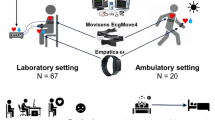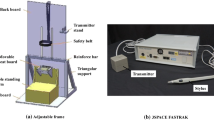Abstract
To validate a new device designed to measure ventilation \( \left( {\dot{V}_{\text{E}} } \right), \) tidal volume (V T), inspiratory time (T I), and expiratory time (T E) during daily life activities. The anteroposterior displacement of the rib cage and abdomen and the axial displacements of the chest wall and the spine were measured using two pairs of magnetometers. \( \dot{V}_{\text{E}} \) was estimated from these four signals, and was simultaneously measured using a spirometer. A total of 707, 732, and 1,138 breaths were analyzed in sitting, standing, and exercise conditions, respectively. We compared \( \dot{V}_{\text{E}} \), V T, T I, and, T E measured by magnetometers (\( \dot{V}_{{{\text{E}}\;{\text{mag}}}} \), V T mag, T I mag, and T E mag) with \( \dot{V}_{\text{E}} \), V T, T I, and T E measured by a spirometer (\( \dot{V}_{{{\text{E}}\;{\text{spiro}}}} \), V T spiro, T I spiro, and T E spiro, respectively). For pooled data \( \dot{V}_{{{\text{E}}\;{\text{mag}}}} \), V T mag, T I mag, and T E mag were significantly correlated (p < 0.001) with \( \dot{V}_{{{\text{E}}\;{\text{spiro}}}} \), V T spiro, T I spiro, and T E spiro in sitting and standing positions and during the walking exercise. The mean differences, between \( \dot{V}_{{{\text{E}}\;{\text{mag}}}} \), and \( \dot{V}_{{{\text{E}}\;{\text{spiro}}}} \) for the group, were 10.44, 10.74, and 12.06% in sitting, standing, and exercise conditions, respectively. These results demonstrate the capacity of this new device to measure \( \dot{V}_{\text{E}} \) with reasonable accuracy in sitting, standing, and exercise conditions.







Similar content being viewed by others
References
Aaron EA, Seow KC, Johnson BD, Dempsey JA (1992) Oxygen cost of exercise hyperpnea: implications for performance. J Appl Physiol 72:1818–1825
Achten J, Jeukendrup AE (2003) Heart rate monitoring: applications and limitations. Sports Med 33:517–538
Bouchard DR, Trudeau F (2008) Estimation of energy expenditure in a work environment: comparison of accelerometry and oxygen consumption/heart rate regression. Ergonomics 51:663–670
Brage S, Brage N, Franks PW, Ekelund U, Wareham NJ (2005) Reliability and validity of the combined heart rate and movement sensor Actiheart. Eur J Clin Nutr 59:561–570
Brischetto MJ, Millman RP, Peterson DD, Silage DA, Pack AI (1984) Effect of aging on ventilatory response to exercise and CO2. J Appl Physiol 56:1143–1150
Corder K, Brage S, Wareham NJ, Ekelund U (2005) Comparison of PAEE from combined and separate heart rate and movement models in children. Med Sci Sports Exerc 37:1761–1767
Corder K, Brage S, Ekelund U (2007) Accelerometers and pedometers: methodology and clinical application. Curr Opin Clin Nutr Metab Care 10:597–603
Crouter SE, Churilla JR, Bassett DR Jr (2008) Accuracy of the Actiheart for the assessment of energy expenditure in adults. Eur J Clin Nutr 62:704–711
Davidson L, McNeill G, Haggarty P, Smith JS, Franklin MF (1997) Free-living energy expenditure of adult men assessed by continuous heart-rate monitoring and doubly-labelled water. Br J Nutr 78:695–708
De Vries HA, Adams GM (1972) Comparison of exercise responses in old and young men. II. Ventilatory mechanics. J Gerontol 27:349–352
Durnin JV, Edwards RG (1955) Pulmonary ventilation as an index of energy expenditure. Q J Exp Physiol Cogn Med Sci 40:370–377
Ford AB, Hellerstein HK (1959) Estimation of energy expenditure from pulmonary ventilation. J Appl Physiol 14:891–893
Fruin ML, Rankin JW (2004) Validity of a multi-sensor armband in estimating rest and exercise energy expenditure. Med Sci Sports Exerc 36:1063–1069
Garet M, Boudet G, Montaurier C, Vermorel M, Coudert J, Chamoux A (2005) Estimating relative physical workload using heart rate monitoring: a validation by whole-body indirect calorimetry. Eur J Appl Physiol 94:46–53
Gibson GJ, Pride NB, O’Cain C, Quagliato R (1976) Sex and age differences in pulmonary mechanics in normal nonsmoking subjects. J Appl Physiol 41:20–25
Grimby G, Sodderholm B (1962) Energy expenditure of men in different age groups during level walking and bicycle ergometry. Scand J Clin Lab Invest 14:321–328
Hanson JS, Tabakin BS, Levy AM, Hill DB (1968) Comparative exercise-cardiorespiratory performance of normal men in the third, fourth and fifth decades of life. Circulation 37:345–360
Haskell WL, Yee MC, Evans A, Irby PJ (1993) Simultaneous measurement of heart rate and body motion to quantitate physical activity. Med Sci Sports Exerc 25:109–115
Jakicic JM, Marcus M, Gallagher KI, Randall C, Thomas E, Goss FL, Robertson RJ (2004) Evaluation of the SenseWear Pro Armband to assess energy expenditure during exercise. Med Sci Sports Exerc 36:897–904
Johnson BD, Dempsey JA (1991) Demand vs. capacity in the aging pulmonary system. Exerc Sport Sci Rev 19:171–210
King GA, Torres N, Potter C, Brooks TJ, Coleman KJ (2004) Comparison of activity monitors to estimate energy cost of treadmill exercise. Med Sci Sports Exerc 36:1244–1251
Levine JA, Eberhardt NL, Jensen MD (1999) Role of nonexercise activity thermogenesis in resistance to fat gain in humans. Science 283:212–214
Livingstone MB, Coward WA, Prentice AM, Davies PS, Strain JJ, McKenna PG, Mahoney CA, White JA, Stewart CM, Kerr MJ (1992) Daily energy expenditure in free-living children: comparison of heart-rate monitoring with the doubly labeled water (2H2(18)O) method. Am J Clin Nutr 56:343–352
Mc Connel AK, Davies CTM (1992) A comparison of the ventilatory responses to exercise of elderly and younger humans. J Gerontol Biol Sci 47:B137–B141
McCool FD, Paek D (1993) Measurements of ventilation in freely ranging subjects. Res Rep Health Eff Inst (59):1–17; discussion 57–69
McCool FD, Kelly KB, Loring SH, Greaves IA, Mead J (1986) Estimates of ventilation from body surface measurements in unrestrained subjects. J Appl Physiol 61:1114–1119
McCool FD, Wang J, Ebi KL (2002) Tidal volume and respiratory timing derived from a portable ventilation monitor. Chest 122:684–691
Mittman C, Edelman NH, Norris AH, Shock NW (1965) Relationship between chest wall and pulmonary compliance and age. J Appl Physiol 20:1211–1216
Montoye HJ (1982) Age and oxygen utilization during submaximal treadmill exercise in males. J Gerontol 37:396–402
Nilsson A, Brage S, Riddoch C, Anderssen SA, Sardinha LB, Wedderkopp N, Andersen LB, Ekelund U (2008) Comparison of equations for predicting energy expenditure from accelerometer counts in children. Scand J Med Sci Sports 18:643–650
Ohkawara K, Tanaka S, Ishikawa-Takata K, Tabata I (2008) Twenty-four-hour analysis of elevated energy expenditure after physical activity in a metabolic chamber: models of daily total energy expenditure. Am J Clin Nutr 87:1268–1276
Paek D, McCool FD (1992) Breathing patterns during varied activities. J Appl Physiol 73:887–893
Plasqui G, Westerterp KR (2007) Physical activity assessment with accelerometers: an evaluation against doubly labeled water. Obesity (Silver Spring) 15:2371–2379
Poulin MJ, Cunningham DA, Paterson DH, Rechnitzer PA, Ecclestone NA, Koval JJ (1994) Ventilatory response to exercise in men and women aged 55 to 86 years of age. Am J Respir Crit Care Med 149:408–415
Prioux J, Ramonatxo M, Hayot M, Mucci P, Préfaut C (2000) Effect of ageing on the ventilatory response and lactate kinetics during incremental exercise in man. Eur J Appl Physiol 81:100–107
Rousselle JG, Blascovich J, Kelsey RM (1995) Cardiorespiratory response under combined psychological and exercise stress. Int J Psychophysiol 20:49–58
Saltin B, Astrand PO (1967) Maximal oxygen uptake in athletes. J Appl Physiol 23:353–358
Schneider PL, Crouter SE, Lukajic O, Bassett DR Jr (2003) Accuracy and reliability of 10 pedometers for measuring steps over a 400-m walk. Med Sci Sports Exerc 35:1779–1784
Schneider PL, Crouter SE, Bassett DR (2004) Pedometer measures of free-living physical activity: comparison of 13 models. Med Sci Sports Exerc 36:331–335
Smith JC, Mead J (1986) Three degree of freedom description of movement of the human chest wall. J Appl Physiol 60:928–934
Snodgrass JJ, Leonard WR, Tarskaia LA, Schoeller DA (2006) Total energy expenditure in the Yakut (Sakha) of Siberia as measured by the doubly labeled water method. Am J Clin Nutr 84:798–806
Spurr GB, Prentice AM, Murgatroyd PR, Goldberg GR, Reina JC, Christman NT (1988) Energy expenditure from minute-by-minute heart-rate recording: comparison with indirect calorimetry. Am J Clin Nutr 48:552–559
Thomas E (2005) Validation of heat flux technology to assess energy expenditure during exercise. University of Pittsburgh, Pittsburgh
Turner JM, Mead J, Wohl ME (1968) Elasticity of human lungs in relation to age. J Appl Physiol 25:664–671
Wasserman K, Van Kessel AL, Burton GG (1967) Interactions of physiological mechanisms during exercise. J Appl Physiol 22:71–85
Wasserman K, Whipp B, Casaburi R (1986) Respiratory control during exercise. In: Fishman A, Cherniak NS, Widdicombe JG (eds) Handbook of physiology: the respiratory system, a control of breathing. American Physiological Society, Bethesda MD, pp 595–620
Acknowledgments
The authors wish to acknowledge all the subjects for their participation in the study.
Conflict of interest statement
This study was funded through the SVP (“SurVeiller pour Prévenir”) and the “PucesCom.Santé” project. There is no conflict of interest in this research. The six authors have participated in the development and implementation of the protocol and to write this article.
Author information
Authors and Affiliations
Corresponding author
Additional information
Communicated by Susan Ward.
Electronic supplementary material
Below is the link to the electronic supplementary material.
Rights and permissions
About this article
Cite this article
Gastinger, S., Sefati, H., Nicolas, G. et al. Estimates of ventilation from measurements of rib cage and abdominal distances: a portable device. Eur J Appl Physiol 109, 1179–1189 (2010). https://doi.org/10.1007/s00421-010-1463-1
Accepted:
Published:
Issue Date:
DOI: https://doi.org/10.1007/s00421-010-1463-1




